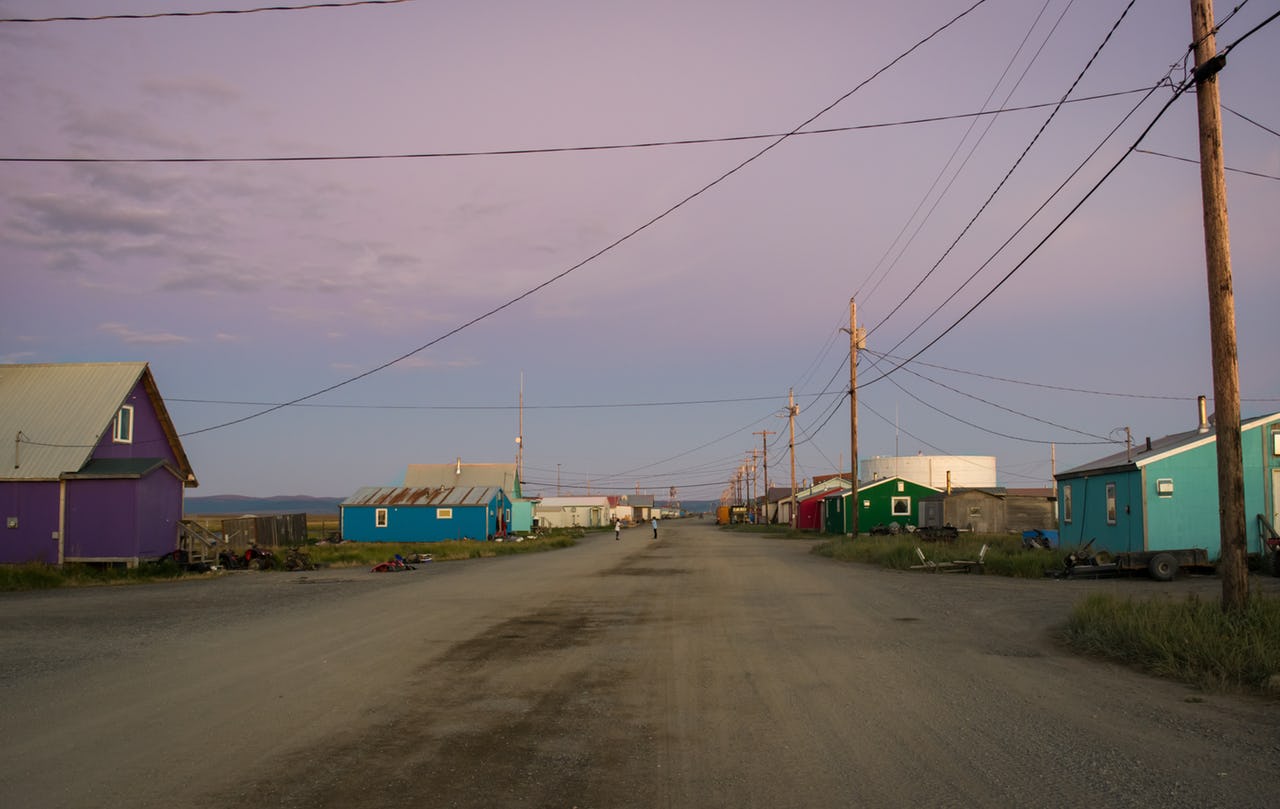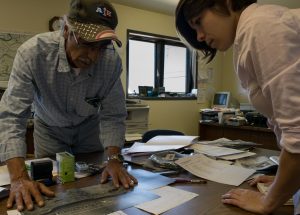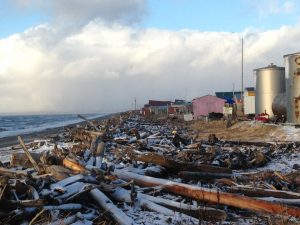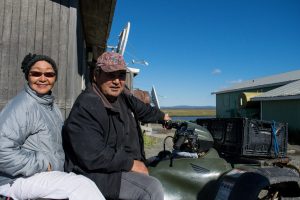Fighting the Rising Tide in Shaktoolik, Alaska

Shaktoolik at sunset. Photo: Eli Keene
As part of The Arctic Institute’s Summer Reading Series, we are reposting stories from Managing Director Victoria Herrmann’s National Geographic-funded project, America’s Eroding Edges.
The edges of our country are eroding, raising difficult questions about adaptation, relocation, and what it means to be an American experiencing climate change today. To connect the shared experiences of Americans facing these dramatic transformations, the National Trust for Historic Preservation has partnered with Victoria as she travels around the U.S. and its territories interviewing communities directly affected by shoreline erosion and climate change.
The Arctic Institute Summer Readings 2017
- A Continual State of Emergency: Climate Change and Native Lands in Northwest Alaska
- Self-Preservation: Amid Debate, An Alaskan Village Decides to Move Inland
- When the Sea Wall Breaks: Climate Change in Teller, Alaska
- Fighting the Rising Tide in Shaktoolik, Alaska
- Climate Change Hope in America
- A Delicate Balance of Commerce and Climate Change in Nome, Alaska
- Frontier of Change
The first thing you notice about Shaktoolik is its vibrancy.
That vibrancy is clear from the end of the village’s small gravel air strip, where two massive wind turbines dance constantly in the gusts. Houses line either side of the village’s only road, painted in vivid shades of turquoise, green, red, blue, and purple. The expansive landscape of the Tagoomenik River to the east and Norton Sound to the west bookends the view. And further down the road, beyond the modern school building and city council office that anchor the village, kids play outside on trampolines and sip on neon slushies bought from the community center as their parents head out on four-wheelers to pick berries on the tundra.
The second thing you notice about Shaktoolik is its driftwood.
The village’s westward beach is covered with hundreds of dried, paling logs, washed ashore from the mouth of the Yukon Delta further south. The wood is a beautiful and somewhat odd sight, given that the nearest trees to the village itself are miles away in the foothills.
But what makes for a nice addition to the beach during calm summer days causes problems for Shaktoolik when the fall storms roll through. As storm surges batter the beach, water drives logs up the shore, eroding the sand and damaging homes, buildings, and critical infrastructure such as the diesel tank farm.
“A lot of erosion, yeah, that’s no secret, this village is eroding,” Gary Bekoalok tells us, pouring a cup of coffee from a thermos. Gary has taken us upriver by boat to see the full extent of Shaktoolik’s exposure to flooding. He’s brought us first to his cabin, which he built from reclaimed wood from the village dump. In the quiet of his camp, Gary thinks about what’s next for his village: “One day we will have a catastrophic event, just a matter of time.”
A small village of 260 people, Shaktoolik sits on a 1-mile sand and gravel spit and faces danger of complete inundation from both sides. As log-filled waves chip away at its western shoreline and threaten to wash over the village, the river system on its eastern front swells with intense rainfall. When both happen simultaneously, Shaktoolik becomes a temporary island, stranding its residents and requiring evacuation to the elevated school building or an airlift to another settlement. The Army Corps of Engineers has identified Shaktoolik as one of Alaska’s villages in most imminent danger of becoming uninhabitable. A 50-year storm event will drown the community.
As a construction worker, Gary knows the dangers of building a village atop narrow silt between two bodies of water. He reflects, “If we had a flooding event that sustained its force and the high water saturated the ground, that’s all you need to say.”
Still, despite this vulnerability, Shaktoolik feels active and resilient. Walking past the brightly colored houses, it is difficult to grasp that this community faces dire risk of irreparable harm. There is hope here.
Much of that hope emanates from Shaktoolik’s mayor, Eugene Asicksik. Every community in Alaska has its champions, but Eugene seems to live and breathe this role. He’s helped to build a community center, brought clean energy to the village, and over the past year has led the community in constructing a self-financed berm of gravel and driftwood to protect the village from storm surges and help stave off erosion.
Eugene has the tendency to check in daily, pulling up on his four-wheeler to say hi. Over the course of these check-ins, it becomes clear that his philosophy is one of self-help. “If the village wants something, it has to come from the village. There needs to be blood, sweat, and tears,” he says.
Eugene walks us through a long list of community-driven improvement projects. “This community put in our own water and sewer,” he tells us, “and we’ve got windmills with 200 kilowatts generating capacity.”
Eugene understands the importance of working with the government. As Shaktoolik’s “politician,” he is constantly working alongside governmental agencies. But he also recognizes that the disconnect between a remote Native community and officials in Anchorage or D.C. can be a costly one.
“The government comes in here and has preconceived ideas and plans and their own workers, with no community engagement. But there’s always another way to solve a problem and get other benefits,” he says.
Shaktoolik has clearly built up its internal problem-solving capacity. And it’s this capacity that led the Shaktoolik Native Corporation to construct the berm for protection against the storms. But for that story, Eugene sends us to the second story of the Native Corporation’s grocery store to meet the Corporation’s manager, Fred Sagoonick.

“We’ve been having meetings about this [erosion] thing and outside agencies have been studying this thing for so long we’re just kind of resigned to another planning session,” Fred tells us. “They’ve already spent God knows how many hundreds of thousands or millions of dollars on these types of meetings, these types of planning sessions when that money could have gone for more infrastructure like building a seawall or starting a road or a bridge or at least the first three miles [of one]. It is frustrating having these meetings after meetings after meetings and nothing gets done. And so the last couple of years the city has taken it on as its own to actually start doing something, which is the berm that you see out there.”
The berm is the only defense the community has. As with other communities in Alaska, Shaktoolik used to be protected from the power of fall storms by miles of shore ice. But higher temperatures have meant this ice isn’t forming—and last winter the village had no ice at all. With the ice gone, the berm is the only thing that stands between the village and the waves of driftwood.
The high gravel mound, which runs the length of the village, will help buy Shaktoolik time, but it ultimately won’t be enough to save it. The Village Corporation’s next big project is to somehow finance a 15-mile road to the foothills that would serve as a route both for evacuating and for eventually relocating the village.
“We know that sooner or later we will have to move. We’re fighting against the rising tide,” Fred tells us.
Shaktoolik’s inevitable move won’t be its first. Back at Gary’s cabin, he explains how Shaktoolik has moved before. “Before Old Site, the village was right back here, about two miles that way,” he says, pointing back through some woods. “So the government built that school down [at Old Site], and the village moved down there, and from there they moved to the site we now occupy. So in 100 years we’ve moved twice already—pretty well experienced,” he laughs.

About two miles down the road from the edge of Shaktoolik’s current town site sits an array of abandoned wooden buildings. Beach erosion has crept up to these buildings over the years, and some of them now teeter over the sand. This is what residents commonly refer to as Old Site—where the Bureau of Indian Affairs school was built. This was the location of Shaktoolik for some thirty years, before storm damage and erosion forced the community to move up the road to the current location.
Even on a calm day, wandering around the tall grass at Old Site leaves you with an odd feeling. Two miles up the road, a vibrant community is building new infrastructure and thinking about the future. Yet Old Site is a reminder that there is a limit to even the most resilient community’s ability to adapt.
As Eugene reminds us, a big storm can leave the village with no escape route, especially if both the river and Norton Sound flood. “Whatever you see back there up to the tree line,” Eugene says, gesturing to the foothills, miles in the distance, “all of that is under water. It turns into a big bay.”
No one in Shaktoolik denies this vulnerability. Pulling out several maps of the village, Fred Sagoonick points out just how much erosion Shaktoolik has already experienced. “We have storm surges during these major fall storms that are easily 10 to 12 feet above normal,” he says, “and we’ve been lucky, call it divine providence, we’ve been spared maybe three for four storms. But one of these days it will go over, not a doubt about it, not in my mind.”
The commentary was originally published on April 10, 2017.

